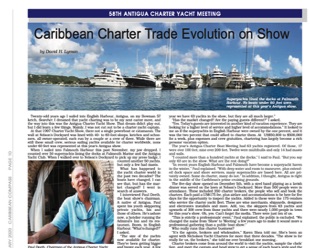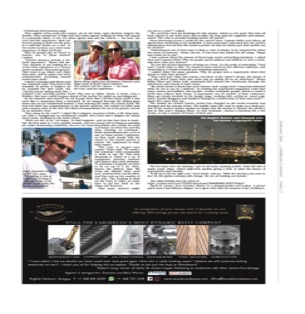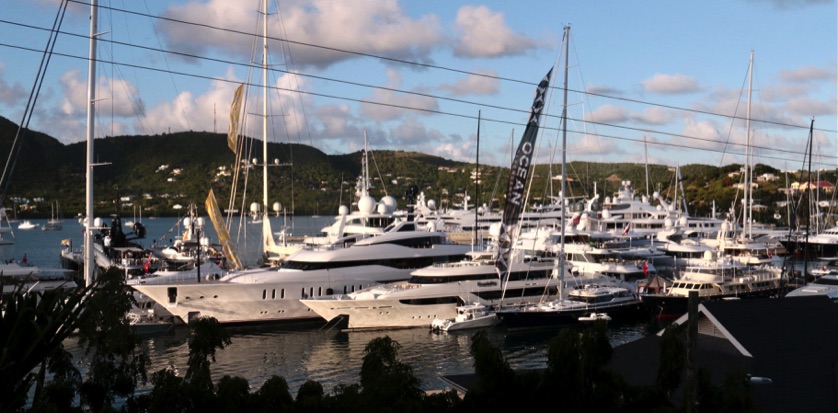


The 2019 Antigua Charter Yacht Show
A look at the charter yacht world
and how it has changed in 60 years.
Story and photos by David H. Lyman
This story ran in the February 2020 edition of Caribbean Compass Magazine
Twenty-odd years ago I sailed into English Harbour, Antigua, on my Bowman 57 ketch, Searcher. I dreamed that yacht charting was to be my next career move, and the way into this was the Antigua Charter Yacht Show. That dream didn’t play out, but I did learn a few things. Mainly, I was not cut out to be a charter yacht captain.
At that 1997 Charter Yacht Show, there not a single powerboat or catamaran. The wall at Nelson’s Dockyard was lined with 40- to 60-foot sloops, ketches and schooners, all owner-operated, each run by a couple or a crew of three. While there are still these small crew, serious sailing yachts available for charter worldwide, none under 60 feet was represented at this year’s Antigua show.
I’M When I sailed into Falmouth Harbour this past November, my jaw dropped. I counted over 50 superyachts lining the docks at Falmouth Marine and the Antigua Yacht Club. When I walked over to Nelson’s Dockyard to pick up my press badge, my jaw dropped. I counted over 50 superyachts lining the docks at Falmouth Marine and the Antigua Yacht Club. No boats under 60 feet were represented at this year’s Antigua show. , but only a few had masts.
What has happened to the yacht charter world in the past two decades? The boats have changed, I can see that, but has the mar- ket changed? I went in search of answers.
I interviewed Paul Deet, Show chairman. A native of Antigua, Paul spent his youth skippering private yachts, his and those of others. He’s ashore now, a hotelier running the Admiral’s Inn and its restaurant, Boom, in English Harbour.
“What’s changed?” I asked.
“The size of the yachts now available for charter. They’ve been getting bigger and bigger each year. A few years ago we had over 150 boats in the show. This year we have 63 yachts in the show, but they are all much larger.”
“Has the market changed? Are the paying guests different?” I asked.
“Yes. Today’s guests are interested in another kind of vacation experience. They are looking for a higher level of service and higher level of accommodations.” It looked to me as if the superyachts in English Harbour were owned by the one percent, and it was the two percent that could afford to charter them. At US$50,000 to $500,000 for a week, plus expenses and crew gratuities, chartering has largely become a rich persons’ vacation option.
The year’s Antigua Charter Boat Meeting had 63 yachts registered. Of those, 17 were over 100 feet, nine over 200 feet. Twelve were multihulls and only 14 had masts and sails.
“I counted more than a hundred yachts at the docks,” I said to Paul. “But you say only 63 are in the show. What are the rest doing?”
“In recent years English Harbour and Falmouth have become a superyacht haven in the winter,” Paul explained. “With deep water and room to maneuver, plus extend- ed dock space and shore services, many superyachts are based here. All are pri- vately owned. Some do charter, many do not.” In addition, I thought, Antigua is right in the middle of the Caribbean’s prime cruising grounds.
The five-day show opened on December 5th, with a steel band playing as a lavish dinner was served on the lawn at Nelson’s Dockyard. More than 500 people were in attendance. These included 350 charter brokers, the people who sell and book the charters. Each paid a US$175 fee, plus airfare and accommodations to be here for five days for the opportunity to inspect the yachts. Added to these were the 175 vendors who service the charter yacht fleet. These are wine merchants, shipyards, designers and electronics installers and more. Add, too, the skippers from 63 yachts and upwards of 300 crew from those yachts and there were nearly 1,000 people in town for this year’s show. Oh, yes. Can’t forget the media. There were just ten of us.
“This is strictly a professionals’ event,” Paul explained; the public is excluded. “We changed the name from ‘Show’ to ‘Meeting’ a few years ago to make it sound more a professional gathering than a public boat show.”
Who really runs this charter business?
“It’s the agents, brokers and wholesalers,” Karen Shea told me. She’s been an agent with Nicholson Yacht Charters for more that three decades. “The show is for really for us, the brokers,” she told me over breakfast one morning..
Charter brokers come from around the world to visit the yachts, sample the chefs’ fare, and meet the captain and head stew to get a sense of each boat’s style and the
Paul Deeth, Chairman of the Antigua Charter Yacht Meeting, says, ‘Today’s guests are interested in another kind of vacation experience.’
counted another 50 yachts, but only a few had masts.
What has happened to the yacht charter world in the past two decades? The boats have changed, I can see that, but has the mar- ket changed? I went in search of answers.
I interviewed Paul Deeth, the boat show’s chairman. A native of Antigua, Paul spent his youth skippering private yachts, his and those of others. He’s ashore now, a hotelier running the Admiral’s Inn and its res- taurant, Boom, in English Harbour. “What’s changed?” I asked.
“The size of the yachts now available for charter. They’ve been getting bigger and bigger each year. A few years ago we had over 150 boats in the show. This hospitality of the crew
They explore every nook and cranny, sit on the beds, open drawers, inspect the shower. They remind me of high-end real estate agents, looking for what will appeal to a potential client, or not. It’s these agents who sell the charter — the boat, the crew and the experience. After all,
you do in a year?” I asked.
“We currently have six bookings for this season, which is very good. But time off from charter is not down time; this is when the boat gets her upgrades and mainte- nance. The crew is actually working harder off charter.”
Does chartering return a profit for the owner? Paul, Captain Ottley and others all agreed that chartering is not profitable. It does feed some cash back into the yacht’s maintenance but not into the owner’s pocket. So why do owners put their yachts out for charter?
“Chartering is one of best ways to keep a crew in shape, to be prepared for when the owner is onboard,” Ottley told me. It was Paul who added the old adage, “Ships and crews rot in port.”
I was curious about the owners of these large motor and sailing machines. I asked Paul and Captain Ottley: Why do people spend millions and millions to own a yacht, why don’t they just charter?
“It’s not the actual experience of being on a boat, it’s the pride of ownership,” Paul said. I could relate to that. I’ve owned or been owned by five different sailboats, and ownership is a deeply personal and satisfying experience.
I asked Ottley the same question. Why do people own a superyacht when they spend so little time aboard?
“They each have their own reason, but there is the owner’s dream, the dream of one day they’ll board their own yacht and go sailing off on an adventure.” Karen Kelley Shea and Ottley both mentioned that owners live vicariously through the adventures and travels of their crews.
“My owner wants to know how each charter, each voyage went. I keep him informed when we are at sea on a delivery.” In reading the superyacht magazines I find that many owners are builders, idea people, creative enterprise people, driven to build a world that reflects their vision. A superyacht can be another of their endeavors. Many get deeply involved in the design stage, working with architects, naval engi- neers, system designers and builders during the construction of their next yacht — many have more than one.
The market for crewed charter yachts has changed as the world economy has changed and the rich get richer. The middle class that used to make up a large por- tion of the crewed charter market no longer has the means to charter the yachts I saw at this year’s Antigua Show, so they downsize, charter a bareboat for a few weeks, or buy a modest 40-footer of their own.
The English Harbour and Falmouth area has become a superyacht haven.
The five days were eye opening. I got to see some amazing yachts, some the size of small cruise ships, others high-tech models giving a hint of what the future of superyachts may become.
“It all up in the air right now,” Paul Deeth, told me. “With the election next year in the US, the global economy will change. We are all holding our breath.”
See video footage from the show at https://vimeo.com/user779335/download/384899986/d05747ddc9
David H. Lyman, from Camden, Maine, is a photojournalist and author. A former yacht owner and delivery skipper, he’s spent more than 20 seasons in the Caribbean.